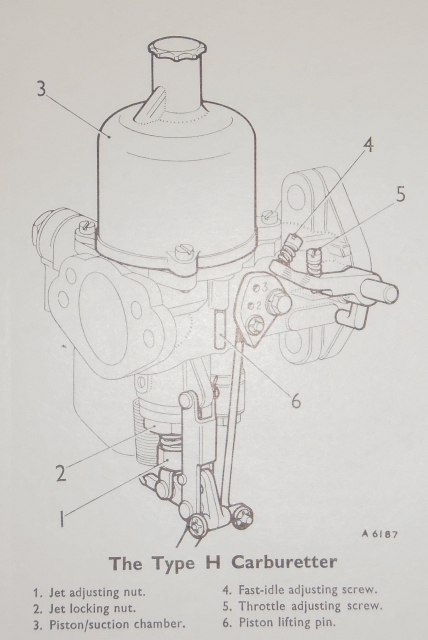QuestionQUESTION: hi Barrie -My 74 MGB is running hot and blasts very hot air into the cabin. The engine runs cool for awhile but invariably, the needle creeps up little past the 'N', once I have driven about 20 minutes high speed. Prior to this the gauge was never past midway between C and N. I have added new electronic ignition, plugs etc.., overhauled the SU carbs, added new radiator, new hoses, flushed system twice, tested and ran with a new 160F thermostat, then removed thermostat, same overheating. The heater valve works fine. The car has a new oil cooler, new fan belt, new water pump. The coil feels pretty hot to touch after running. It is 12V ballast type. I have read that electronic ignition timing could be wrong or that fuel mixture is too lean? .
Any ideas on what I can try next? Thanks!
 SU Carburetter type H
SU Carburetter type H
ANSWER: Hi Paul. From the symptoms that you describe, I would suspect that the engine timing is not sufficiently advanced. What sort of electronic ignition system have you fitted? Is it a new distributor, or have you fitted a black box to your old distributor? Did you time it with a stroboscope after fitting? I cannot tell you whether you have a problem with a ballasted coil unless I know exactly what electronic system you have fitted.
If the timing is OK, then maybe you have a problem with fuel quality. The 1974 MGB was designed to run on 99 octane gas with NO ethanol. If you are using lower octane this would be enough to cause trouble.
As regards a weak fuel mixture, you can check it yourself. The SU carburetters on your car should have lifting pins. I attach a picture of an earlier type of carb which clearly shows the lifting pin labelled as item #6.
When the engine is warm, leave it running on tickover and lift the front pin with your finger. You should be able to hear the engine slightly increase in speed and then the speed should drop. Do the same with the rear carburetter and it should have the same effect.
If the speed rises and stays up, then the mixture is too rich.
If the speed drops without first rising then it is too weak.
If one carb has a bigger effect than the other, then the carbs need to be balanced.
---------- FOLLOW-UP ----------
QUESTION: Thanks Barrie! - well here goes..checked the mixture via lift pins and both carbs dropped off to stall point. I am running with a new Petronix flamethrower, with 3 Ohm, 12V ballasted coil with the resistor wiring connected. Gas here is 94 Octane, not sure if it has 10 per cent ethanol. I used a timing gun, and found that timing was 25 degrees BTDC at 1000 rpm, and based on Haynes manual ( my engine code is 18V 837 Z ) I think the timing should only be 15 Degrees at 1000 rpm so I adjusted (retarded it a little). Test drive - no difference in power. Seems quite smooth at high speed. No pinging either, but engine still takes long time to reach max heat, after which time I am feeling lots of heat inside and gauge is midway. Tested for manifold leaks with propane - negative. Funny but I just noticed that there is small amount of gas exiting the tailpipe during idle...Oh and my plugs are NGK BPR6EY and burning very white. What do you think? Make it richer?
AnswerHi Paul. It sounds like you are slowly solving your problem. It is important to make one change at a time, otherwise you cannot tell which change has had an effect.
I am concerned that 94 octane is a bit low, so I agree that 15 degrees advance at 1,000 rpm is the highest you should go, definitely not 25 degrees. This measurement must be measured with the vacuum pipe disconnected from the distributor advance mechanism.
Ballasted coil with resistive wiring still connected is fine.
Your sparks plugs have resistors. I would replace them with BP6EY.
Your mixture setting is too weak. You need to enrich both carbs until the revs RISE before they fall. When correct the plugs will be straw coloured, not white.
